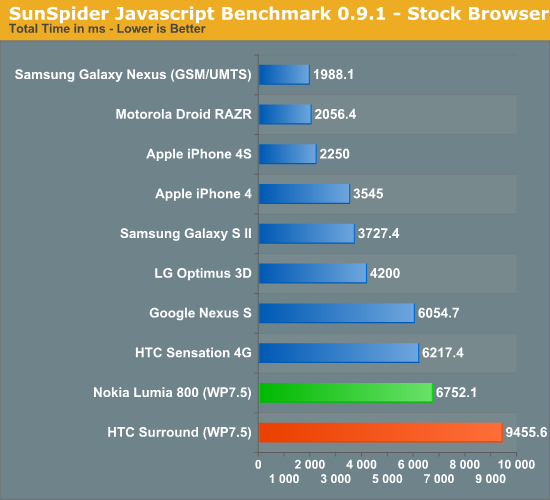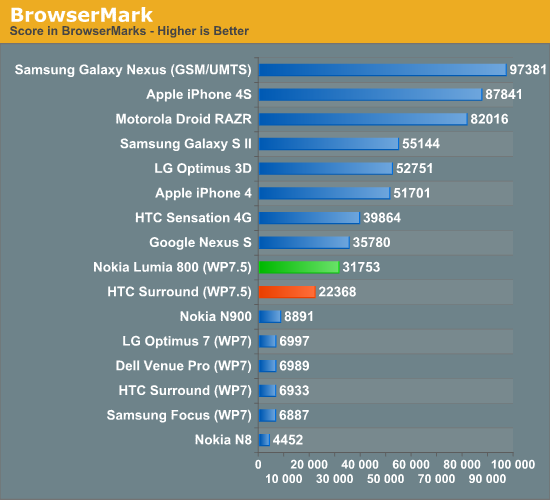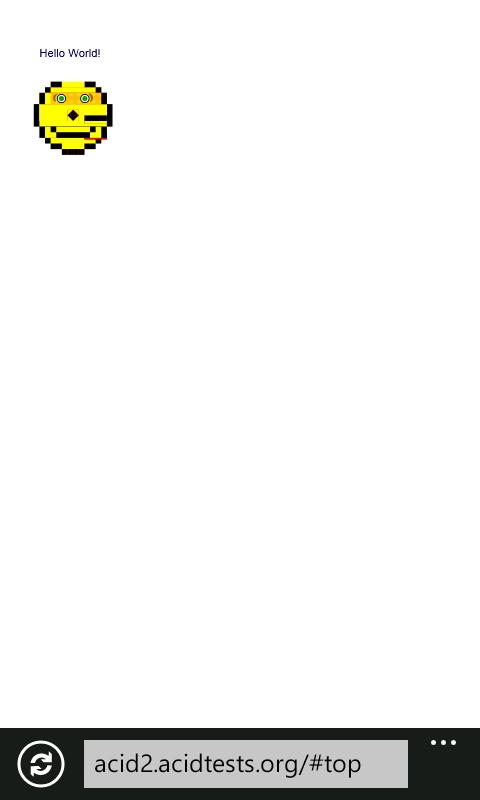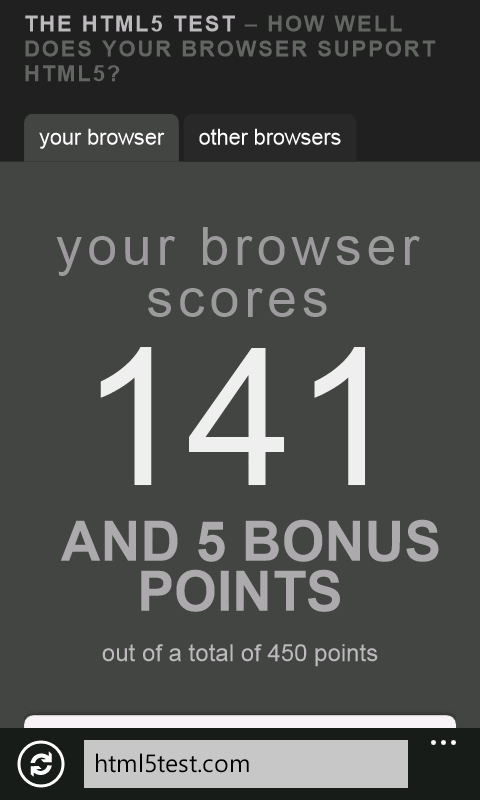Nokia Lumia 800 Review - Nokia's Brave New Foray into WP7
by Brian Klug on January 4, 2012 7:00 AM EST- Posted in
- Smartphones
- Nokia
- windows phone 7
- Mobile
- WP7
- Lumia
- Lumia 800
Unfortunately, the majority of benchmarks that usually grace our smartphone reviews don’t yet have WP7 ports or analogs, but there are a still a number of comparisons we can make. To start, the browser-based performance metrics give a good picture within the Windows Phone ecosystem, and likewise with WPbench, created by one of our own readers and on the marketplace.
There’s been a lot written about performance on WP7 already - namely that comparative analysis isn’t as big of a deal as it is on other smartphone platforms, but of course this is more the result of two things. First, Microsoft’s careful curation of their new smartphone platform with hardware requirements; second, availability of native and managed code execution environments. For the most part, you can pick up any WP7 device and have very good expectation of UI smoothness, but that’s not to say there aren’t differences, especially as the platform moves from one generation of Snapdragon SoC to the next, and now possibly even a move to ST-E. Benchmarking WP7 (and by analog, Windows 8) will become a big deal very soon, however, and numerous SoC vendors and big names in the PC benchmarking scene are looking to port to these platforms.
This current refresh of WP7 devices continues to be based around exclusively Qualcomm SoCs, and the Lumias are no exception. Both the 710 and 800 are based around Qualcomm’s MSM8255 single core S2 Snapdragon at 1.4 GHz with Adreno 205 graphics at the core and dual channel LPDDR2 memory interfaces. This is a 45nm part we’ve seen and explored numerous times before, and as a refresher includes the HSPA+ 14.4 baseband onboard.
Anyhow, onward to the numbers. First is sunspider, which we’ve been using for a long while and recently changed from 0.9 to 0.9.1 with. As a result, I’ve had to re-run devices since the numbers aren’t directly comparable. WP7.5 brings a much improved javascript engine which gives it a big boost in scores. I’ve managed to hang onto the HTC Surround (1.0 GHz QSD8250) and Anand has the Focus (also 1.0 GHz QSD8250), which we’ve included as well.

Browsermark hasn’t changed or forced us to re-run things, so we have comparison numbers that show how much difference there is in the browser department in WP7.5.

In the synthetics, WP7.5’s new JavaScript engine (Chakra) with JIT brings perf almost up to modern levels and is a step in the right direction, but it’s still behind iOS and Android. Moving to a higher clocked single core probably does make sense for Windows Phone, especially if IE is single threaded at this point.
For system benchmarking on WP7.5 we have WP Bench, which was created by one of our own readers. The benchmark reports a total score in addition to three sub-scores for CPU, memory, and GPU. My only point of comparison, again, is the HTC Surround.
| WPBench Comparison | ||
| HTC Surround (1.0 GHz QSD8250) | Nokia Lumia 800 (1.4 GHz MSM8255) | |
| Total Score | 59.85 | 91.14 |
| Result Screenshot |
|
|
Browser Performance and Changes
I’ve made a big deal about browsing performance because, for me at least, the stock browser is the one place where performance really must be flawless. OEMs are starting to wake up to the fact that browsing performance makes a huge impact on the overall subjective weighting of a platform’s smoothness, which in turn results in a lot of scrutiny. I’d agree with this assertion as well and toss in a few other things that must be flawless for a platform to feel speedy.
When WP7.5 first started surfacing we took a look at its revamped IE9-based browser which uses Trident 5.0 as opposed to NoDo’s Trident 3.1. Unsurprisingly everything we saw in the emulator applies to the real-world experience with WP7.5 on live devices. Actually things are even a bit better than they were when we played around in the emulator.


The Windows Phone team has made clear several times that they aren’t going to build the browser to any tests but instead real-world page rendering accuracy. That said it’s still worthwhile to take a look at the synthetics. Acid 3 now completes and nearly passes (the boxes in top right subtract some points) where it previously scored below 95. Similarly Acid 2 now is almost flawless. Finally, the HTML5test score increases from 130 to 141 on the Lumia 800 and newer WP7.5 builds, which is a slight but still important difference.

Moving away from Trident 3.1 to 5.0 has made a huge difference on faithful page rendering and eliminated nearly all of the annoying edge cases I saw with previous WP7 smartphones. A number of pages I visit daily back when we did those reviews would render but with a few notable errata, these are now gone completely.
In addition, scrolling performance remains just as speedy as it was before (essentially buttery smooth) as the rendering architecture remains largely the same. We now have all three platforms (WP7.5, iOS, and Android 3.x/4.x) rendering the browser page into a texture that can be translated, clipped, and zoomed with GPU operations. It’s clear that this is the right way to do things to keep the browser UI speedy.
The changes to WP7.5’s browser make (for me at least) the single most notable improvement over NoDo and previous iterations. It’s a huge step forwards in rendering, compliance, and UI, and having that browser experience be as close to perfect as possible is tremendously important.












120 Comments
View All Comments
Thermogenic - Wednesday, January 4, 2012 - link
The polycarbonate shell gives it the weight. That's one of the main selling features of the phone, but it's not for everyone.jagor - Wednesday, January 4, 2012 - link
It seems you have the High and Low levels switched in the Display Metrics table. If so, and max brightness is just 196 nits for the High level, you probably should use the High brighness level in the battery tests for an apples to apples comparison.Brian Klug - Wednesday, January 4, 2012 - link
Fixed!-Brian
zvadim - Wednesday, January 4, 2012 - link
I find USB ports on top to be a PIA when using phone in a windshield/dash mount.ReySys - Wednesday, January 4, 2012 - link
Finally no thanks to Microsoft or Nokia Marketing or Carrier in Mexico I´m going to have mine thru Expansys Unlocked! Really a lot to do to market WP7 worldwide! More than 20 models last year but only LG Optimus arrive to Mexico thru Telcel! I decide to wait to mature a little more... My decision was right Optimus has Battery problems. Still Ipm going to buy an, Thinkpad W, Asus Transformer Prime & maybe at last an iphone 5! Sorry IT Administrator & Consultor need to test & from an opinion. Already have 2 blackberrys! I before all of them a Dopod 900! Still functioning! Long wait!Braumin - Wednesday, January 4, 2012 - link
I was hoping for more, I know it is a bit misguided but the opening paragraph said it would look into the new features that Mango brought to WP7. They were barely even talked about.I understand that Apple and Android are dominant, so when they sneeze out a tiny update they get an entire article just for the update. This was just a gloss over of WP7.5. Anandtech should have given it a review on its own.
I know Brian doesn't use WP7 as his smartphone, but quips like this bug me "It’s is telling about the functionality still missing from the core of WP7 that you need to go download a YouTube and Adobe Reader application from the market to use those things"
Well, you don't HAVE to download a YouTube app - you COULD just go to the youtube web page. Is it telling about the functionality still missing from the core of iOS 5 that you still have to install a facebook app? Facebook is fairly well integrated into WP7, and so is twitter. I know it is still missing things, but these are the items that should have come up in the Mango review which just never happened.
steven75 - Wednesday, January 4, 2012 - link
That part about downloading Adobe Reader does sound pretty behind the times to me. Only Microsoft has an OS that can't natively read PDF files (that goes for the desktop too).Braumin - Wednesday, January 4, 2012 - link
I agree about Adobe Reader - sure am glad it is FINALLY going to be native in Windows 8.465thGTG - Wednesday, January 4, 2012 - link
Android can't natively read PDF files without a third party app either, but I don't see what the big deal is regardless. If you try to open a PDF file on a WP7 device it asks if you want to install a PDF reader from the Marketplace and proceeds to do that for you. Painless.Brian Klug - Wednesday, January 4, 2012 - link
I wanted to spend a lot more time codifying why (for me at least) I think that WP7 needs more before it really feels as powerful as Android or iOS. We've been big fans of WP7 for a while now (I was at MIX10 when it launched, and we covered the WP7 launch) but I still can't shake the feeling that it should be more at this point.Codifying that was my original objective for part of this article, and obviously some of that didn't really make it though in the end. I use WP7 now and then, but I'll be first to admit it isn't nearly as much as Android and iOS.
-Brian